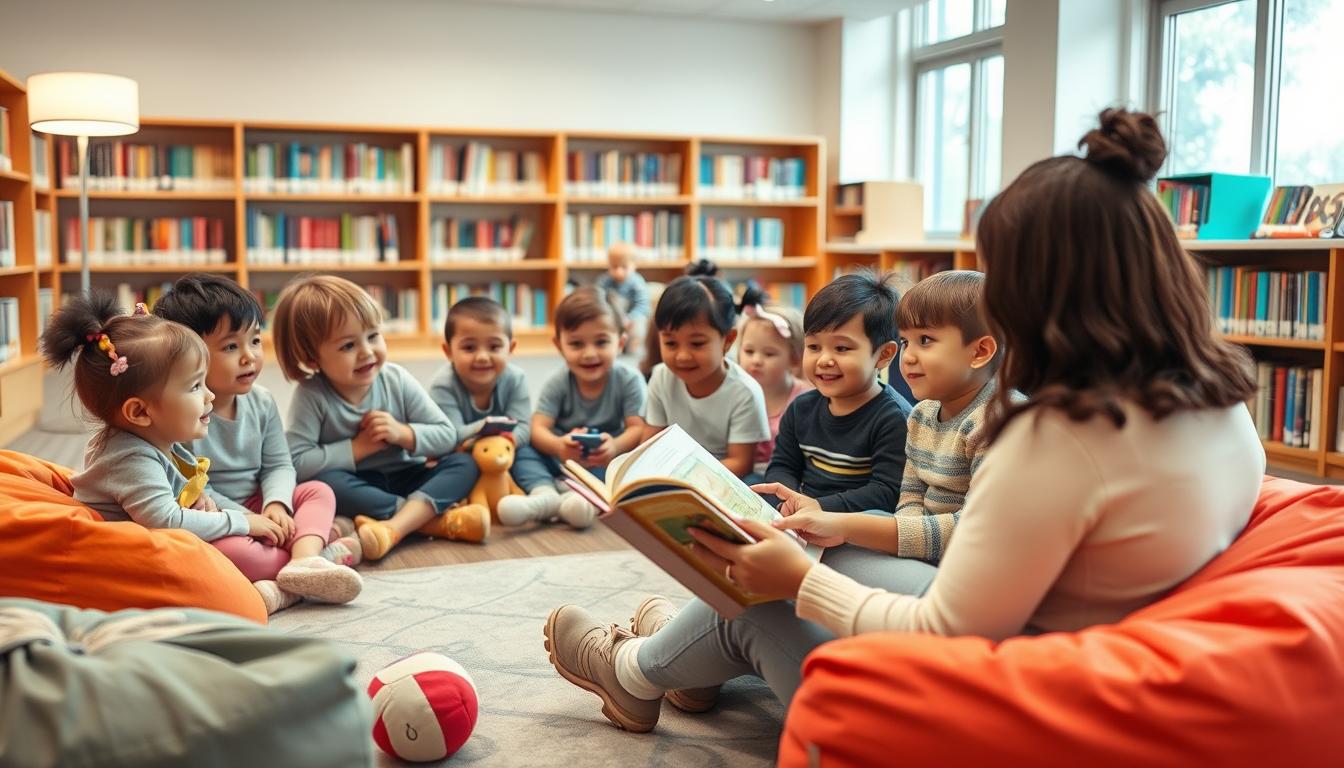Storytime Favorites for Preschoolers
“Children are made readers on the laps of their parents.” — Emilie Buchwald’s timeless words capture the magic of sharing stories with young children. For kids aged 3–5 years, storytime isn’t just entertainment—it’s a launchpad for curiosity, creativity, and connection.
Choosing the right stories for preschoolers means balancing fun narratives with opportunities to grow. Vibrant picture books, rhythmic rhymes, and interactive tales help build early literacy skills while keeping little ones engaged. The best picks blend colorful visuals with simple language that sparks questions and laughter.
For teachers and caregivers, storytime creates shared moments that bridge learning and play. Whether in classrooms or living rooms, these sessions teach empathy, problem-solving, and listening skills. They also give young children confidence to retell stories in their own words—a critical step toward reading independence.
Key Takeaways
- Engaging stories boost attention spans in 3–5-year-olds
- Interactive reading builds vocabulary and pre-reading skills
- Visual-rich books support social-emotional growth
- Flexible formats work for virtual or in-person settings
- Shared reading strengthens family-educator partnerships
Introduction to Engaging Storytimes
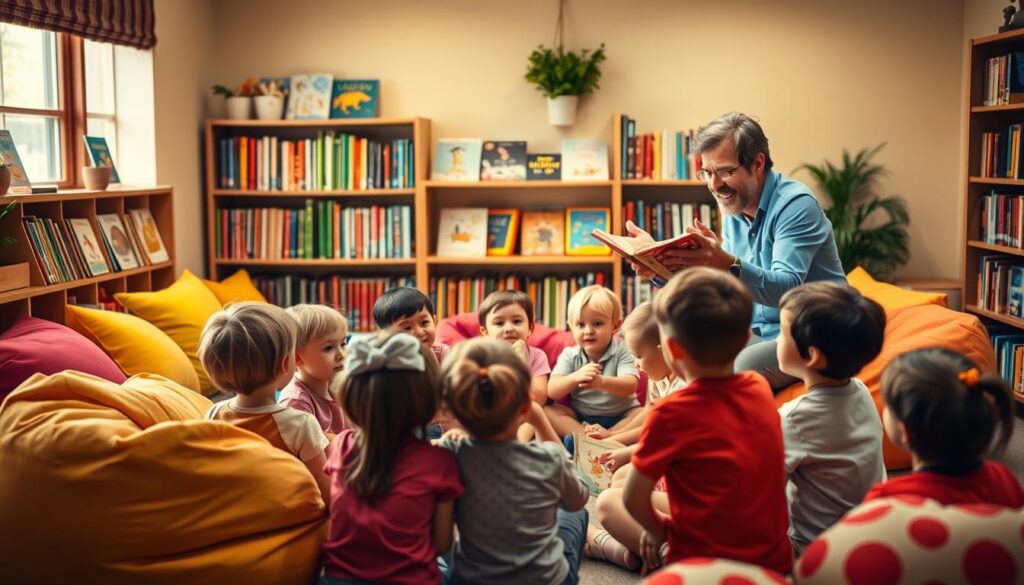
Great storytimes mix learning with giggles and wonder. They turn books into adventures using songs, puppets, and playful questions. Think of it as a recipe: one part story, two parts interaction, and a dash of surprises.
Today’s sessions work anywhere – libraries, parks, or living rooms. Many now use Zoom with locked rooms and sign-ups to keep kids safe. A staff member watches the waiting area, so only approved families join. This lets children wave at friends on screen while following along with “Five Little Monkeys” hand motions.
| Format | Best For | Tools | Safety Steps |
|---|---|---|---|
| In-Person | Group energy | Flannel boards, instruments | Spaced seating |
| Virtual | Flexible timing | Zoom reactions, screen sharing | Password protection |
Top hosts plan 20-minute blocks with quick changes between activities. A typical flow: welcome song → story → scarf dance → goodbye rhyme. This structure helps kids focus while leaving room for spontaneous comments like “Why does the bear wear boots?”
Understanding Preschool Storytime Needs
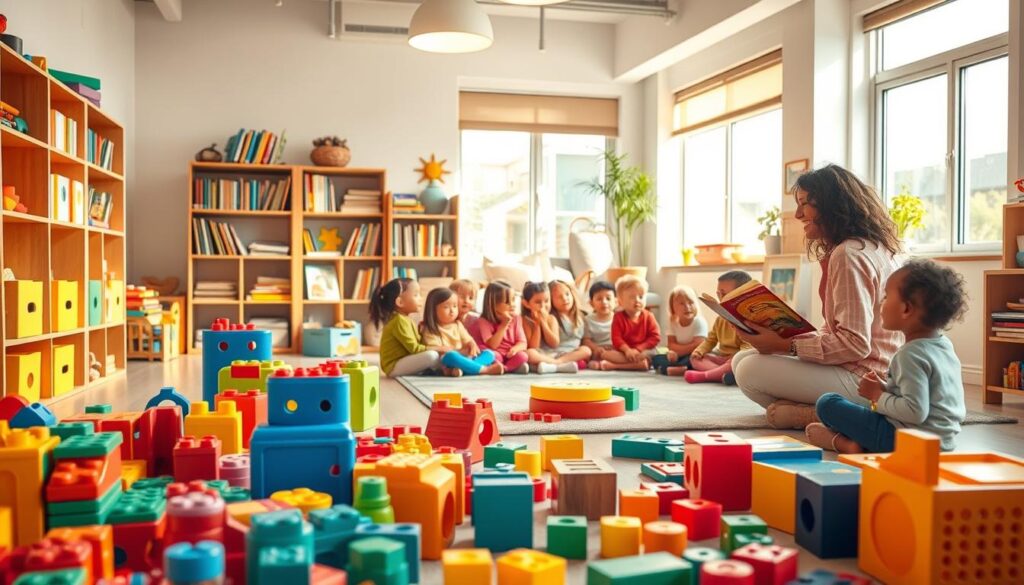
Preschoolers thrive when stories align with their growing abilities. Unlike toddlers who need simple board books, children ages 3–5 crave narratives that challenge their expanding minds. Their developmental stage calls for books blending colorful art with patterns they can predict – think rhyming lines or repeated phrases that let them “read along.”
At this age, kids can focus for 20 minutes if you mix sitting and moving. Try clapping games between pages or asking “What happens next?” to keep their brains engaged. Movement breaks aren’t just fun – they help wire neural pathways for future learning.
Language growth explodes during these years. Stories with wordplay (“Sheep in a jeep!”) or emotional themes (“Why is the owl sad?”) build vocabulary and empathy. Many preschool teachers use “feeling faces” charts so kids can point to emotions characters show.
Little hands need action too. Finger puppets or scarf dances let children ages 4–5 practice coordination while staying immersed in the tale. Remember – successful sessions feel like play, not school. When a giggling group acts out “The Three Bears,” they’re learning teamwork through joy.
Storytime: Creating a Memorable Experience
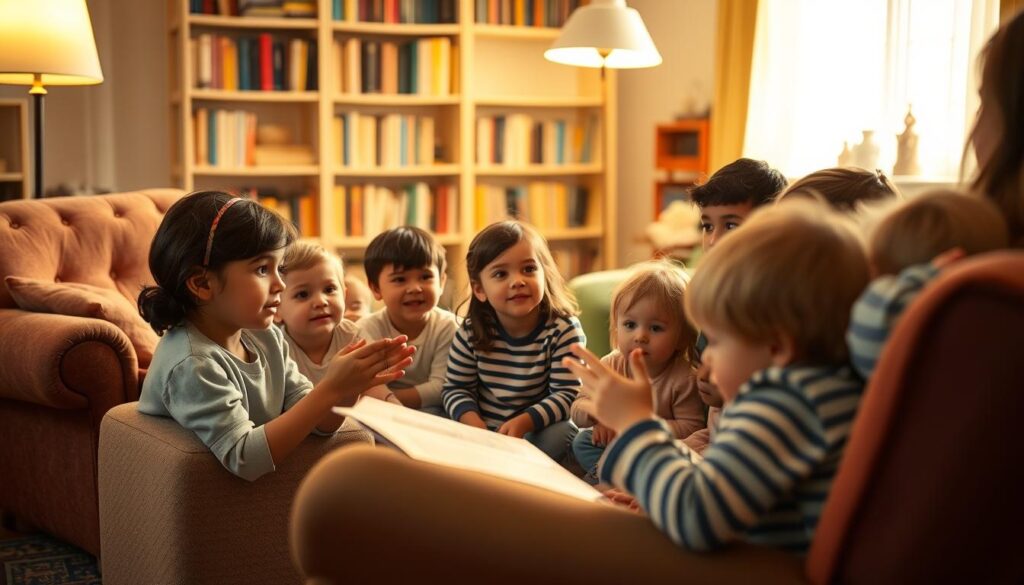
Crafting unforgettable story moments requires more than just reading aloud—it’s about building worlds young minds can touch. Outdoor sessions often face noise challenges, but clever solutions like voice amplifiers and teen volunteers arranged in a diamond formation keep everyone engaged. These helpers hold extra book copies high, ensuring even the wiggliest child sees the pictures.
Start with a “hello sunshine” song or clapping rhythm to signal adventure time. Consistent routines help kids relax, while flexible seating—like rainbow mats or log benches—lets them find their comfort zone. “The magic happens when children feel safe to laugh out loud,” says Portland librarian Mara Lin.
Surprise elements spark wonder. Pull a puppet from a sparkly bag or invite kids to “shake rain” with ribbon rings during a storm scene. Alternate between energetic dances and calm breathing breaks—this rhythm mirrors how young brains process excitement.
Lasting memories form when stories connect to real life. Pause to ask, “Has your stuffed bear ever had a tea party?” Letting little ones share their ideas builds confidence and ties the tale to their world. These moments turn simple readings into shared journeys that children beg to relive.
Choosing the Right Books and Materials
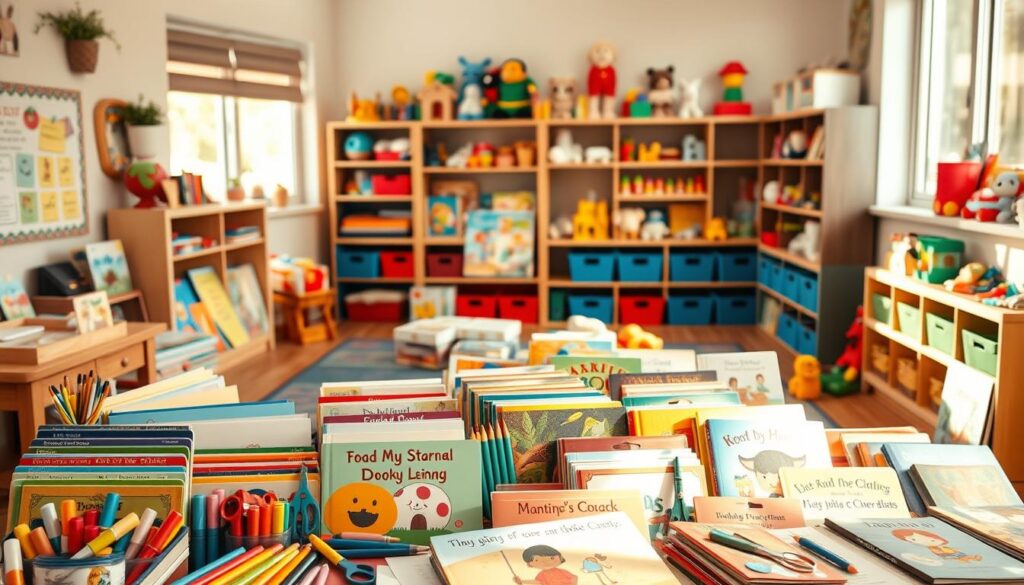
The magic of a preschool reading session begins with books that spark instant curiosity. Titles like “Press Here” and “Hooray for Hat!“ shine because they turn pages into playgrounds. Bold covers with smiling animals or swirling colors act like magnets for young eyes, whispering, “Come see what’s inside!”
Popular Story Choices and Covers
Books that encourage participation always win. “Walter’s Wonderful Web” lets kids trace shapes with their fingers, while “The Rabbit Listened” uses soft illustrations to explore feelings. Look for materials with textures or flaps—“Charlie Chick” surprises readers with a pop-up beak that never fails to delight.
Rhythmic stories like “Grumpy Bird” keep groups giggling while teaching tone changes. Bright covers matter here: a grumpy-faced bird on the front primes kids for funny voices. Rotate between classic tales and new finds to keep your shelf fresh.
Selecting Materials and Props
Props should feel like natural extensions of the story. Giant scarves become oceans for “Swimmy” adventures, while animal puppets help retell “My Heart is Like a Zoo.” Choose items large enough for back-row viewers—a 12-inch felt sun beats a tiny sticker.
Durability is key. Board books survive sticky fingers, while laminated picture cards withstand enthusiastic pointing. Mix in no-prop books too—“Friendshape” needs only hand motions to act out triangle hugs and square dances. Remember, the best materials invite kids to lean in, not tune out.
Designing Interactive Extension Activities
Bringing stories to life requires more than words—it demands hands-on magic that preschoolers can touch and move. Extension activities bridge listening and doing, letting children explore themes through play. These interactive moments turn abstract ideas into tangible discoveries.
Flannelboard and Prop Stick Activities
Flannelboards transform storytelling into a choose-your-own-adventure experience. During “Color Zoo”, kids place felt animals to build shapes, guessing which creature comes next. “Ten Fluffy Chickens” becomes a counting game as children add chicks to a barnyard scene—their giggles erupt when one “flies away!”
Prop sticks boost participation without complicated tools. A simple blue bird stick becomes a flying friend during “Blue Bird, Blue Bird” rhymes. For “Where is Shape?”, kids wave triangle or circle sticks when called—a playful twist on musical chairs that sharpens listening skills.
Great activities adapt to energy levels. Shorten sessions by removing shapes or extend them with color-matching challenges. These props aren’t just fun—they build coordination as little hands grasp, wave, and place items. The secret? Let kids lead sometimes. When a child rearranges flannelboard pieces to make “a purple cow eating stars,” creativity takes center stage.
Virtual vs In-Person Storytimes
Digital screens and park circles offer different stages for sparking young imaginations. Each format brings unique ways to connect with preschoolers, whether through pixel-perfect book close-ups or the contagious laughter of group activities.
Comparing Engagement Methods
Virtual sessions shine when books become magnified adventures. Holding pages inches from the camera lets kids spot tiny ants in “Hey, Little Ant” or count stripes on a caterpillar. Educators often ask, “Can you find something blue in your room?” turning homes into scavenger hunt zones.
In-person storytimes thrive on shared energy. Without props due to distancing, leaders use exaggerated voices and clapping patterns that ripple through crowds. A well-timed “Jump if you see the duck!” turns reading into a full-body game.
Adapting Techniques for Each Format
Screen-based techniques demand simplicity. Color-coded chat responses (“Type 🟢 for yes!”) keep little fingers involved. Pre-recorded segments let kids pause to shout answers at their tablets.
Outdoor gatherings rely on vocal tricks. Leaders position themselves like theater actors, using hillsides as natural amplifiers. Rotating book angles ensures even back-row viewers see pictures clearly—no small feat when reading to 30 wiggly listeners!
| Format | Engagement Tools | Techniques |
|---|---|---|
| Virtual | Camera close-ups, chat functions | Object hunts, pause-and-react |
| In-Person | Voice projection, body movements | Call-and-response, spatial games |
Setting Up a Virtual Storytime Session
Creating engaging virtual sessions for preschoolers starts with smart tech choices and safety planning. Registration systems let organizers balance group sizes while giving families clear access details. Closed Zoom rooms with waiting areas ensure only approved guests join—no surprise visitors during “The Very Hungry Caterpillar” readings!
Registration and Security Measures
Secure sign-ups protect young audiences. Ten-week programs often use platforms like Eventbrite to collect emails and send unique links. A staff member watches the waiting room, checking names against registration lists before granting entry.
| Feature | Purpose | Benefit |
|---|---|---|
| Password Protection | Blocks unauthorized access | Creates safe space for interactions |
| Screen Monitoring | Flags inappropriate content | Allows quick removal of disruptions |
| Attendance Caps | Limits group size | Boosts personalized engagement |
Using Zoom for Interactive Learning
Zoom’s tools turn flat screens into lively classrooms. Hosts use polls to take quick votes (“Should the pig build a brick house?”) and chat for shout-out answers. Screen sharing magnifies book details, making every ladybug spot visible.
| Tool | Use Case | Engagement Type |
|---|---|---|
| Reaction Buttons | Silent participation | Non-verbal responses |
| Breakout Rooms | Small group activities | Peer collaboration |
| Annotation | Circle shapes on pages | Visual learning |
Strong Wi-Fi and ring lights keep sessions smooth. Families appreciate when hosts explain rules upfront: “Mute mics until question time!” These steps help 3–5-year-olds focus on stories, not tech hiccups.
Planning Successful In-Person Storytime Events
Hosting memorable in-person events requires creative thinking and smart logistics. Outdoor spaces transform ordinary readings into adventures under open skies. But balancing safety with fun demands careful planning and clever setup solutions.
Outdoor Setup and Social Distancing
Libraries often partner with local parks through shared agreements to secure ideal locations. Look for flat areas with natural shade and minimal traffic noise. A simple outdoor setup might use yarn measured to ten-foot intervals, marking each family’s space with colorful lawn flags.
| Element | Purpose | Tools |
|---|---|---|
| Spacing | Ensure safe distances | Pre-cut yarn, flags |
| Visibility | Clear sightlines | Teen volunteers in diamond formation |
| Sound | Overcome ambient noise | Voice amplifiers, wireless mics |
Teen helpers play a key role by holding enlarged book copies high above their heads. This lets back-row kids see illustrations without crowding. “We’re not just holding books—we’re creating a theater experience,” notes San Diego volunteer coordinator Lisa Tran.
Always prepare for weather surprises. Waterproof book covers and pop-up tents keep materials dry during unexpected drizzles. With the right setup, outdoor events become joyful gatherings where stories soar alongside butterflies and laughter.
Integrating Movement, Songs, and Rhymes
Movement turns story sessions into playgrounds for young minds. A song cube rolled across the floor might land on “Head, Shoulders, Knees, and Toes”, sparking instant giggles and wiggles. Puppet pals like Two Little Birds teach opposites through flapping high and low, while books with built-in actions have kids stomping like dinosaurs or twirling like autumn leaves.
Smart movement planning balances energy bursts with focused moments. Marching parades get hearts pumping, then finger plays like “Itsy Bitsy Spider” calm busy hands. These physical switches help preschoolers build coordination without overwhelm.
Songs act as secret learning tools. A cleanup tune signals transitions, while rhyming lyrics about hungry caterpillars boost memory. When everyone chants “Bubblegum, Bubblegum in a dish”, shy speakers gain confidence through group rhythm.
Rhymes work magic on growing brains. Predictable patterns in books like “Chicka Chicka Boom Boom” let kids guess upcoming words, building early reading skills. Clapping syllable beats turns language into a game—who knew counting sounds could be this fun?
FAQ
What types of books work best for preschoolers during group sessions?
How can I keep toddlers engaged during virtual sessions?
Are outdoor in-person events effective for social distancing?
What security steps are needed for Zoom-based learning?
Why include songs and movement in every session?
Can flannelboard activities adapt to both live and online formats?
How long should a typical event last for children under 5?

Sharon Molly is a content creator in lifestyle, fashion, and travel, delivering style-savvy advice and destination insights to inspire confident living. With a background in digital media, she combines aesthetics with practical guidance for modern women on the go.

